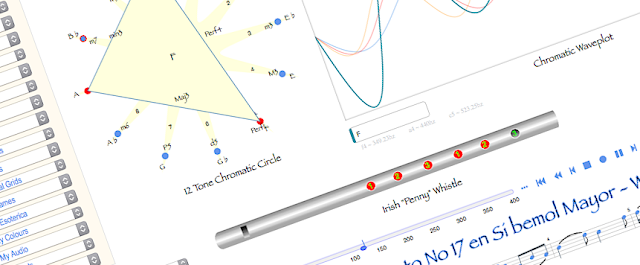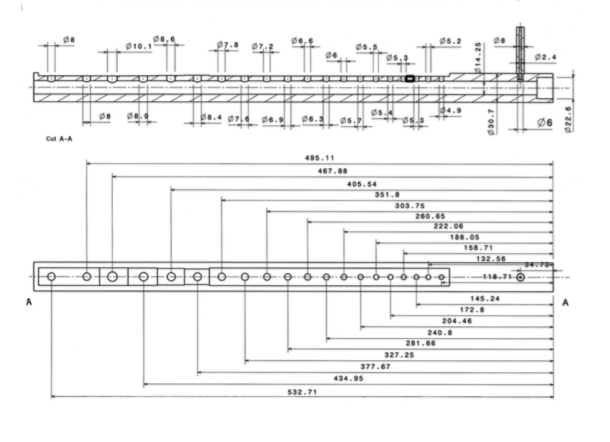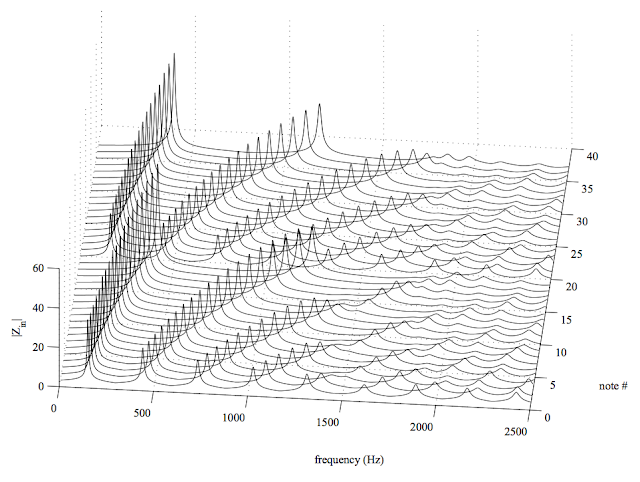Our aim is to provide a platform for the highly interactive visual modeling of any world music instrument - directly in the browser and from a generic, instrument-family base. Yet the musical behaviours of many instruments are both nonlinear and governed by a large range of factors; their visual dimensioning and behaviour correspondingly difficult to model consistently.
Using wind instruments as an example, we try to get a better idea what in-browser instrument modeling challenges to expect.
Big, brave, open-source, non-profit, community-provisioned, cross-cultural and cherry coke crazy. → Like, share, back-link, pin, tweet and mail. Hashtags? For the crowdfunding: #VisualFutureOfMusic. For the future live platform: #WorldMusicInstrumentsAndTheory. Or simply register as a potential crowdfunder..
In-Browser Instrument Modeling
This information augments principles outlined in this blog's Instrument Models menu.
In contrast to the design of physical instruments, our primary goal is neither optimised pitch and balanced timbre through construction excellence, nor mathematically perfect audio synthesis, but the most flexible and easily reusable visual model(s).
Depending on a given instrument's temperament or intonation, tonal mappings will differ. As these will be made via external libraries based on identified note names or extended (n-tone), MIDI-like indexing systems, they and the slight dimensioning disparities inherent in real instruments can be ignored.
Most current approaches to physical modeling are concerned with replicating sound. In this sense, though hardly rocket science, the visual modeling of instruments in the browser has been left somewhat behind. This is now changing.
The good news is that any basic configuration definitions we establish (such as the relative positioning of frets or fingerings on a lute-like instrument) can -with caution- be reused across other instruments and tools.
Nevertheless, we still face a wide range of dimensioning challenges.
In the visual modeling of sophisticated instruments, we have a choice between rigorous physical-mathematical modeling (synthesis, using formulas and parameters), a test-based approach (using, for example, spectral analysis) and an empirical or heuristic (rule-of-thumb or experiential) approach.
For simpler-to-model instruments such as those of the lute family, physical-mathematical models can be universally applied. The resulting layouts are entirely predictable.
For more complex instruments (wind included), it's not so straightforward. The addition of an extra finger hole or key will more often than not affect the positioning of all other holes. Builders tend to carry out extensive tests before committing to a production series, and even then adjustments for variations in material, bore, length, positioning and wall thickness are the norm. This means that for instruments nominally in the same key and with the same scale or channel length, their dimensions may still vary.
Where the overhead in consistently modeling instrument dimensions proves too high. we enter the realm of 'rule of thumb' models. Here, hole positions are arrived at empirically (i.e. neither by physical-mathematical or test methods, but by pragmatic estimation or so-called 'heuristics'). Here, the most powerful tool is the data- (or rather, music-) visualisation designer's modelling intuition. Ideally, one empirical model for hole clusters will prove adaptable to all subsequent instrument family modeling needs. This is by no means impossible. Indeed, it is one of the major strengths of data-driven visualisation techniques.
Wind Instrument Modeling
Hornbostel-Sachs' list of aerophones (wind and free reed instruments) roughly matches that of chordophones in it's extent.
Given this diversity, the challenges in modeling them consistently are formidable. Factors such as channel bore, tapering, wall thickness, wave reflection, variously sized fingerholes and their impact on airflow dynamics lead to complex modeling constraints.
Moreover (and though not important in a visual modeling context), the same results can be obtained from different geometries, yet even minor changes can result in wide differences in tonal accuracy and timbre.
Where for a string instrument, tone and finger position are mapped one-to-one (1:1. and so more or less trivial), wind instruments can exhibit a many-finger-to-one-tone relationship (n:1) and a further, one-to-one (1:1) mapping for any levering system (the mechanics linking tone hole and finger position). In some cases this is further complicated by forked fingerings.
Keep in mind, too, that a central feature of the aggregator platform in focus here is that -if correctly integrated- instrument models are intimately and dynamically linked to any loaded theory tools: changes to one can -if wished- be reflected in the other. This represents distinct and powerful 'added value' over and above existing online instrument modeling offerings.
A further challenge in this context is the so-called pythagorean comma, the slight relational discontinuities that occur with just, or harmonic, tuning systems. In this respect, however, visual animations have the advantage that these can be not only revealed, but their role made intuitively clear.
Empirical, Heuristic or Rule-of-Thumb Models
If finger hole positions associated are based on hard physical evidence, those of heuristic or empirical models can be said to rely more on practical experience and good judgement.
Perhaps the best basis for these models are instrument builder's dimensioning diagrams, which though possibly based on the two other approaches mentioned, also reflect the builder's iterative experience, sometimes spread over many years.
Heuristic models (here a simple example for transverse flute) may allow more flexible and comprehensive mappings between finger position and tone, but given the range of construction parameters, positioning is likely to prove more contentious.
Assuming their scaling can be made to correctly reflect various instrument sizes, we might equally base our models on converted-to-SVG instrument images.
We can, indeed, create an instrument model simply by drag-and-drop, or (as in the example below) by visual estimation. Whatever the approach, the finger position mappings will work fine.
 |
| Penny Whistle Model with Visually Approximated Hole Positions |
Though not rigorous, such approaches are tempting. The problem is that of joint, dynamic configurability with our theory tools..
 |
| How To Integrate Instruments And Theory Tools Across All Possible Musical Configurations? |
Empirical or Test-Based Models
Spectral analysis is a technique used to isolate distinctive sine curve (waveform) features reflecting physical properties such as frequency, amplitude, and phase in sound, electric or light systems.
Above, you can see the harmonic spectrum associated with a single note or tone, that of G4, played on a flute.
Earlier, such research involved the use of an oscilloscope, but digital technologies have extended their application into further graphical dimensions.
Similarly, one can plot an instrument's impedance spectra across a range of notes (such plots can be used to compare designed with built values).
The aim would be to isolate distinctive features in plots such as these, and, using non-linear scaling between known references (such as the octave), to estimate fingerhole positions.
This assumes, of course, that the dimensional scaling used has no discontinuities. 'Devil's hole' instruments such as gaida or register instruments will require special handling. More on this below.
Physical-Mathematical Models
Our focus here here is the application of the basic laws of physics and maths to model (synthesise) the visual appearance of a real instrument, in a manner similar to that done for Lute family instruments.
Sorry to labour a point, but many of the approaches documented in doctoral theses around the world have as goal improved sound synthesis. Our goal is visual modelling.
We can anticipate a number of problems here:
- given the complexity of air flow through a wind instrument, optimisation of any such model will require some form of iteration working from seed values.
- physical-mathematical models may prove acceptably accurate for our needs, but given the sheer range of wind instrument configurations will almost certainly lead to a larger number of individual solutions.
- where for simple whistles and flutes it may be possible to couple instrument and theory tool configurations as has been done with lute family instruments, dynamic, joint configuration will tend to break down for sophisticated instruments such as clarinet or saxophone.
Some examples of modelling discontinuities we can expect:
- 6-hole (2x3-finger) vs 8-hole (2x4-finger) whistle or shepherd's flute vs 3-hole (one-handed) tabor
- chanter with thumb hole (such as the Bulgarian gaida with it's so-called 'devil's hole') vs those with none
- closed-end wind instrument (such as transverse flute) vs open-ended one (such as kaval)
- overblowing instruments vs those with some form of register change key or hole.
Forked fingerings should not be regarded as a discontinuity as these are not determined by algorithm, but represent n:1 mappings between calculated hole (or finger) positions and specific notes. They are, in a word, decoupled.
Here an example of an online calculator for flute hole positioning, of which there are several. Here another, but capable of generating a 3D, x-y-z gimballed image. Current weaknesses are that their dimensioning and positioning algorithms:
- apply only to 12TET instruments
- take no account of conical bore
I expect there are more sophisticated models out there somewhere. Whatever the approach chosen, however, it is central to the 'mutual, dynamic configuration' philosophy of the aggregator platform that -as for the lute family- multiple temperaments and intonations can be accommodated. Instruments can then, for configuration purposes, be directly linked to the corresponding abstract theory tools.
Choice of Modelling Method
From a reuse perspective, it would be desirable if, as is the case for the Lute family, a structured, widely applicable physical-mathematical approach can be taken. For sophisticated instruments, however, some form of compromise (possibly involving a mix of modelling approaches) seems likely.
Where stringed instrument families can be seamlessly and interactively reconfigured, wind instruments seem likely to be subject to more dynamic configuration discontinuities.
Happily, the vast majority of world music instruments -wind or otherwise- are simple in their construction. Modelling a wide range of instruments should prove simple enough given a scaleable model for hole positions.
To close: successful visual models are most likely to come from the music, programming and engineering communities. Many already exist as 'island' solutions, only needing aggregated into a single, open platform.
The majority of solutions will be instrument-family-dedicated, but reflecting and supporting this diversity in it's simplest, most generic and reusable form is the goal of this platform. If it can be done, this is the place to do it.
We most definitely do not have all the answers, but trust that on a planet with around 8 billion inhabitants, other's imaginations and motivation are fired. If we can provide the vehicle, others will provide the content. Social Value is all.
Keywords
online music learning,
online music lessons
|
distance music learning,
distance music lessons
|
remote music lessons,
remote music learning
|
p2p music lessons,
p2p music learning
|
music visualisation
music visualization
|
musical instrument models
interactive music instrument models
|
music theory tools
musical theory
|
p2p music interworking
p2p musical interworking
|
comparative musicology
ethnomusicology
|
world music
international music |
folk music
traditional music
|
P2P musical interworking,
Peer-to-peer musical interworking
|
WebGL, Web3D,
WebVR, WebAR
|
Virtual Reality,
Augmented or Mixed Reality
|
Artificial Intelligence,
Machine Learning
|
Scalar Vector Graphics,
SVG
|
3D Cascading Style Sheets,
CSS3D
|
X3Dom,
XML3D
|






Comments, questions and (especially) critique welcome.